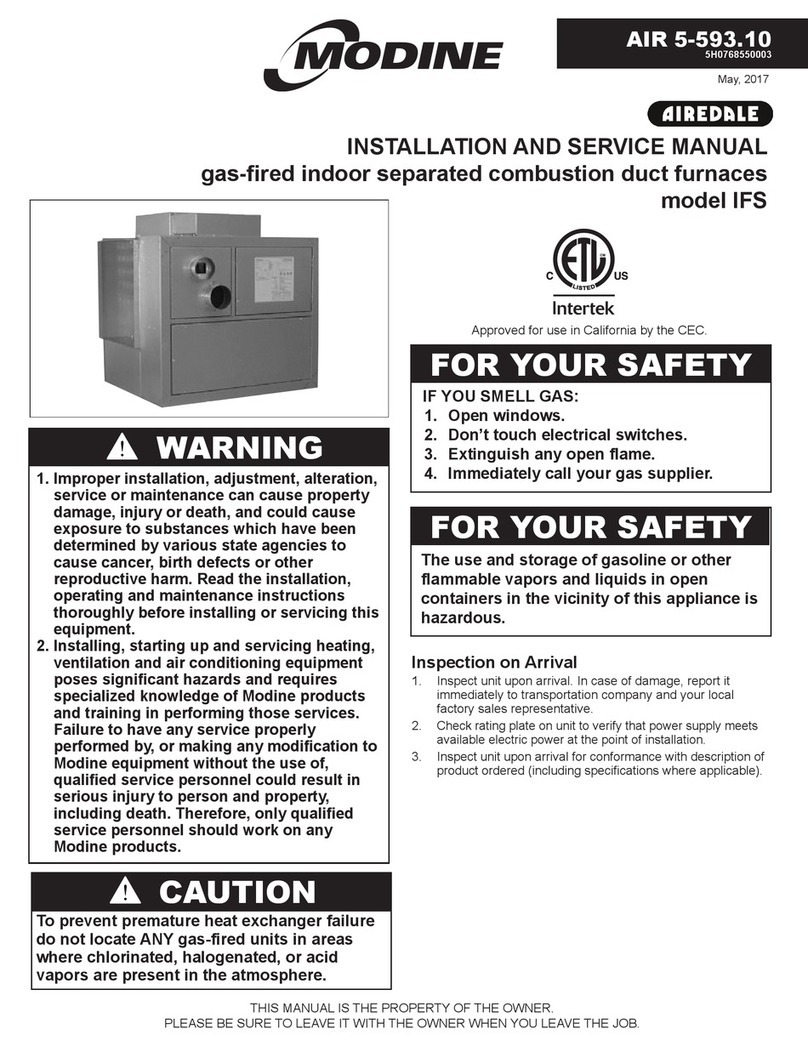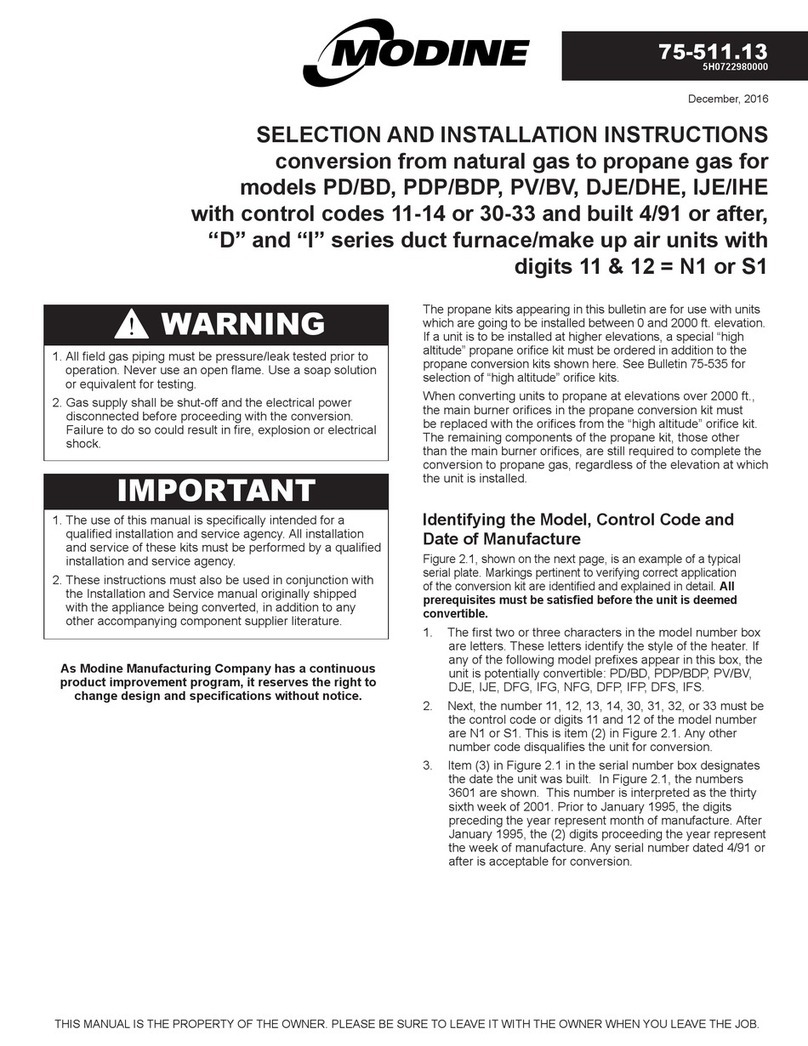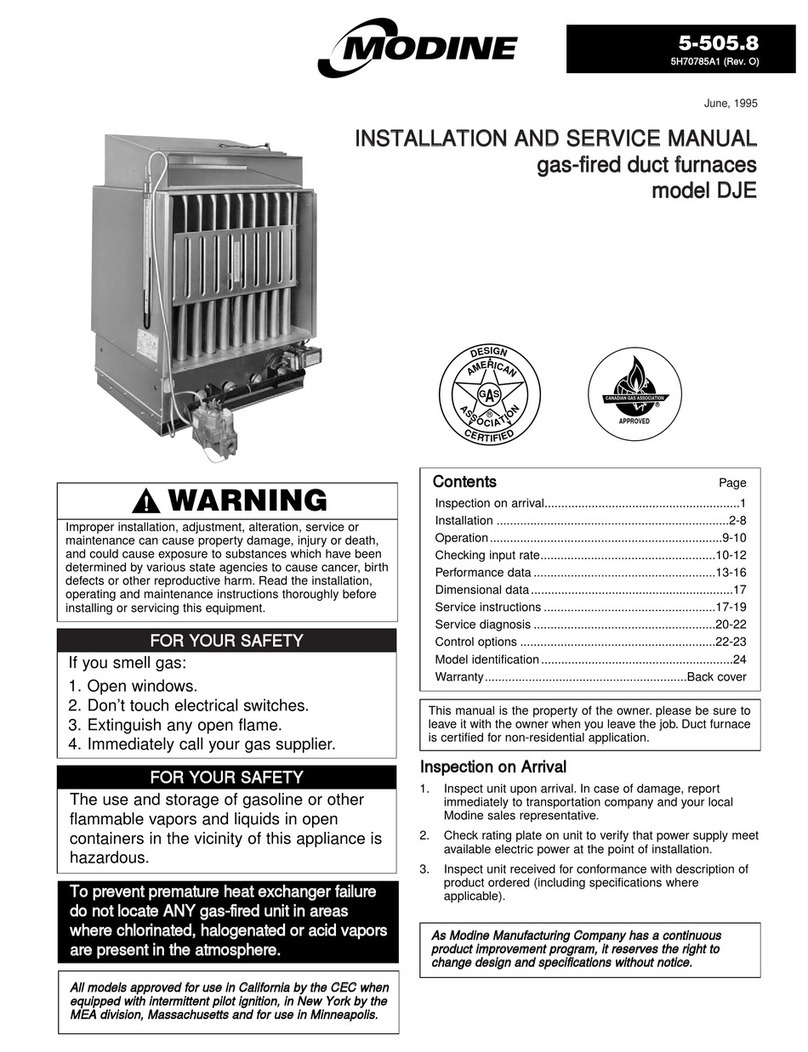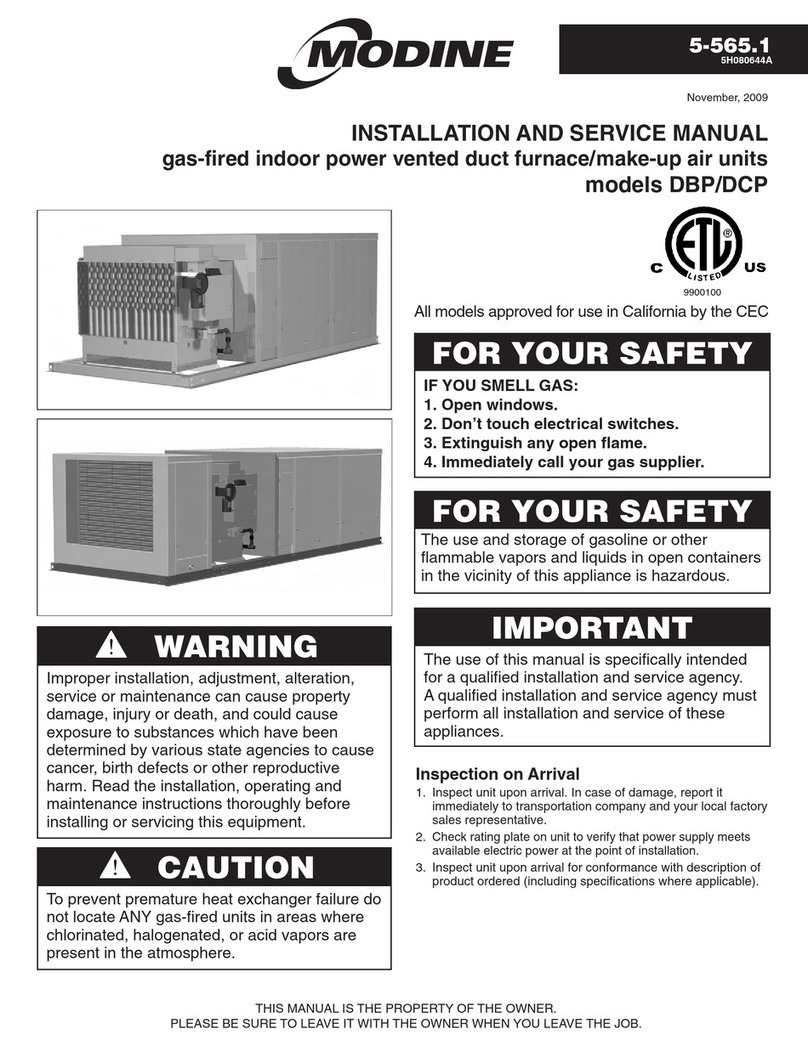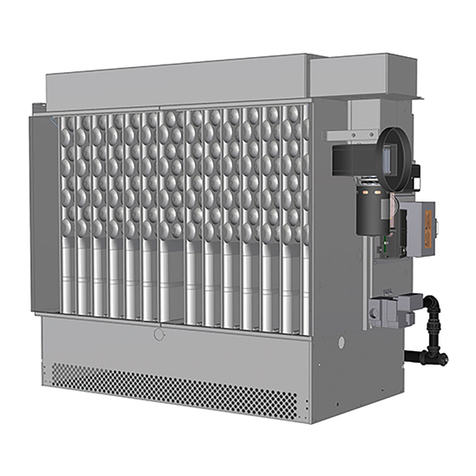
5-571.4
10
➀ After the thermostat calls for heat, the power exhauster relay is energized starting the power exhauster motor. Once the motor has reached full speed, the power
exhauster centrifugal switch closes energizing the gas control circuit.
10
START-UP PROCEDURE
Control Operating Sequence
All Modine weatherproof duct furnaces are supplied with
intermittent pilot ignition systems. These systems are offered
with 100% shut-off with continuous retry for operation on
natural gas and 100% shut-off with lockout for units operating
on propane gas. On all systems, both the main burner and pilot
burner are turned off 100% when the thermostat is satisfied.
For natural gas units, the ignition controller is 100% shut-off
with continuous retry. On a call for heat, the system will attempt
to light the pilot for 70 seconds. If the pilot is not sensed for
any reason, the ignition control will wait for approximately six
minutes with the combination gas control closed and no spark.
After six minutes, the cycle will begin again. After three cycles,
some ignition controllers lockout for approximately one hour
before the cycle begins again. This will continue indefinitely until
the pilot flame is sensed or power is interrupted to the system.
For propane gas units, the ignition controller is 100% shut-off
with lockout. On a call for heat, the system will attempt to light
the pilot for 70 seconds. If the pilot is not sensed for any reason,
the ignition control will lockout, the pilot gas valve shut off and
the sparking discontinued. The system will not attempt to relight
until power has been interrupted to the controls and the controls
are reset via the thermostat.
NOTE: Gas Control Options (see page 12) could change the
listed sequence of operation based on their function.
The descriptions given are for the basic duct furnace.
Single-Stage Gas Controls
Utilizes a single-stage combination gas control, an ignition
control, and a single-stage low voltage thermostat.
1. The thermostat calls for heat. For HFP units, see ➀.
2. The pilot valve opens and the spark ignitor sparks in an
attempt to light the pilot. (If the unit was not provided with a
time delay relay, the blower starts at this time.)
3. Once the pilot is lit, the flame sensor proves the pilot and
stops the spark ignitor from sparking.
4. The main gas valve is opened and the main burner is lit to
100% full fire.
5. If the unit was provided with a time delay relay, the blower
starts after 30 to 45 seconds.
6. The unit continues to operate until the thermostat is
satisfied, at which time both the main and pilot valves close
100%. (If the unit was not provided with a time delay relay,
the blower stops at this time.)
7. If the unit was provided with a time delay relay, the blower
stops after 30 to 45 seconds.
Two-Stage Gas Controls
Utilizes a two-stage combination gas control, an ignition control,
and a two-stage low voltage thermostat. The unit fires at 50%
fire on low stage and 100% fire on high stage.
1. The thermostat calls for low stage heat. For HFP units, see ➀.
2. The pilot valve opens and the spark ignitor sparks in an
attempt to light the pilot. (If the unit was not provided with a
time delay relay, the blower starts at this time.)
3. Once the pilot is lit, the flame sensor proves the pilot and
stops the spark ignitor from sparking.
4. The main gas valve is opened and the main burner is lit to
50% fire.
5. If the unit was provided with a time delay relay, the blower
starts after 30 to 45 seconds.
6. If the temperature at the thermostat continues to fall, the
thermostat will call for high stage heat.
7. The main gas valve is opened completely and the main
burner is lit to 100% full fire.
8. The unit continues to operate until the high stage of the
thermostat is satisfied, at which time the main valve closes
to 50% fire.
9. The unit continues to operate until the low stage thermostat
is satisfied, at which time both the main and pilot valves
close 100%. (If the unit was not provided with a time delay
relay, the blower stops at this time.)
10. If the unit was provided with a time delay relay, the blower
stops after 30 to 45 seconds.
Electronic Modulating Gas Controls
Single Furnace
Utilizes an electronic modulating/regulating gas control,
combination gas valve, an ignition control, modulating amplifier,
and either a modulating room thermostat or modulating
duct thermostat with remote temperature set point adjuster.
The thermostat controls can modulate the gas flow between
40% through 100% full fire. When the thermostat is satisfied,
the amplifier cuts power to the combination gas valve which
prevents gas flow to both the main and pilot burners.
When duct sensing is utilized, a room override thermostat can
be added. When calling for heat, the room override thermostat
provides full fire operation until the space temperature is
satisfied. Control is then returned to the duct sensing control.
In this situation, either the duct sensor or the room override
thermostat can call for heat.
1. The thermostat calls for heat. For HFP units, see ➀.
2. The pilot valve opens and the spark ignitor sparks in an
attempt to light the pilot. (If the unit was not provided with a
time delay relay, the blower starts at this time.)
3. Once the pilot is lit, the flame sensor proves the pilot and
stops the spark ignitor from sparking.
4. The main gas valve is opened and the main burner is lit to
100% full fire.
5. If the unit was provided with a time delay relay, the blower
starts after 30 to 45 seconds.
6. The modulating gas valve can be controlled by either
an electronic modulating room or duct thermostat. The
thermostat can modulate the firing rate between 40%
through 100% full fire. The call for heat is created by a
resistance signal (8000 to 12000 ohms) in the thermostat.
The amplifier converts this resistance into a DC voltage (0
to 12 volts DC with 0 volts high fire and 12 volts low fire).
The output voltage is applied to the modulating gas valve to
control the gas flow to the main burner. As the temperature
drops, the voltage drops causing the modulating valve to
open further. If the discharge air temperature increases,
the voltage increases causing the modulating valve to
close allowing less gas flow to the main burner. For further
information regarding the operation of the electronic
modulating system, consult the literature provided with the
unit.
7. The unit continues to operate in this manner until the
thermostat is satisfied, at which time both the main and
pilot valves close 100%. (If the unit was not provided with a
time delay relay, the blower stops at this time.)
8. If the unit was provided with a time delay relay, the blower
stops after 30 to 45 seconds.
IMPORTANT
To prevent premature heat exchanger failure, with all control
systems, a blower starting mechanism must be provided so
that the blower is running or energized within 45 seconds of
the gas control operation.


















